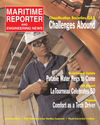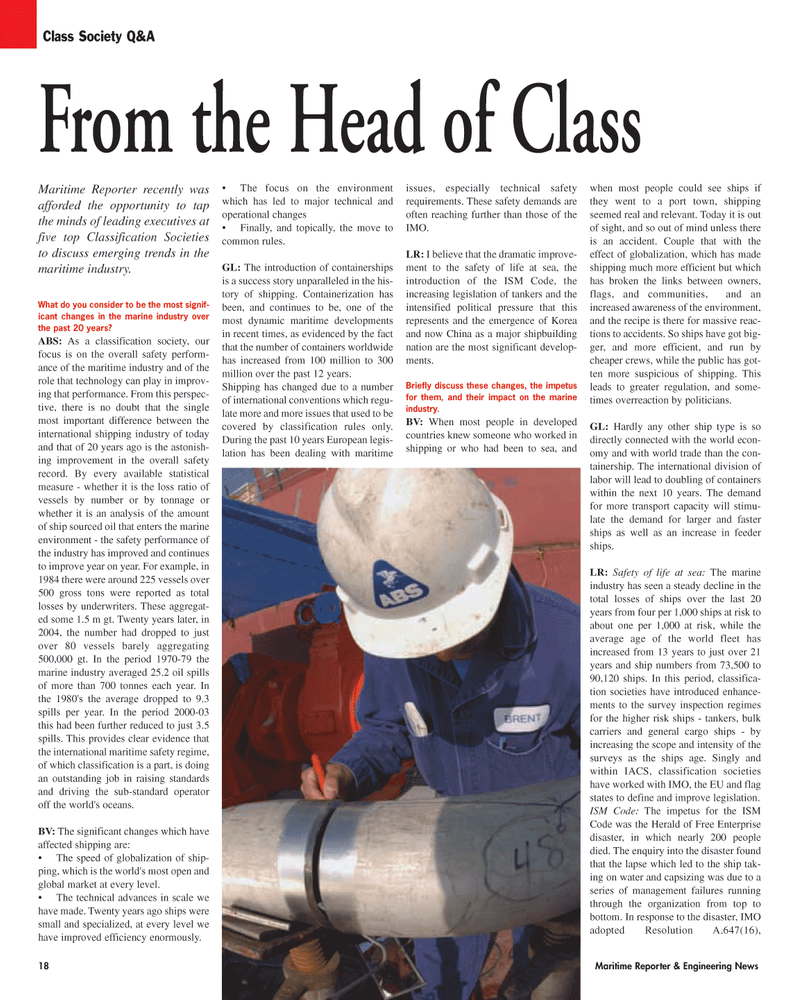
Page 18: of Maritime Reporter Magazine (August 2005)
AWO Edition: Inland & Offshore Waterways
Read this page in Pdf, Flash or Html5 edition of August 2005 Maritime Reporter Magazine
Maritime Reporter recently was afforded the opportunity to tap the minds of leading executives at five top Classification Societies to discuss emerging trends in the maritime industry.
What do you consider to be the most signif- icant changes in the marine industry over the past 20 years?
ABS: As a classification society, our focus is on the overall safety perform- ance of the maritime industry and of the role that technology can play in improv- ing that performance. From this perspec- tive, there is no doubt that the single most important difference between the international shipping industry of today and that of 20 years ago is the astonish- ing improvement in the overall safety record. By every available statistical measure - whether it is the loss ratio of vessels by number or by tonnage or whether it is an analysis of the amount of ship sourced oil that enters the marine environment - the safety performance of the industry has improved and continues to improve year on year. For example, in 1984 there were around 225 vessels over 500 gross tons were reported as total losses by underwriters. These aggregat- ed some 1.5 m gt. Twenty years later, in 2004, the number had dropped to just over 80 vessels barely aggregating 500,000 gt. In the period 1970-79 the marine industry averaged 25.2 oil spills of more than 700 tonnes each year. In the 1980's the average dropped to 9.3 spills per year. In the period 2000-03 this had been further reduced to just 3.5 spills. This provides clear evidence that the international maritime safety regime, of which classification is a part, is doing an outstanding job in raising standards and driving the sub-standard operator off the world's oceans.
BV: The significant changes which have affected shipping are: • The speed of globalization of ship- ping, which is the world's most open and global market at every level. The technical advances in scale we have made. Twenty years ago ships were small and specialized, at every level we have improved efficiency enormously. The focus on the environment which has led to major technical and operational changes Finally, and topically, the move to common rules.
GL: The introduction of containerships is a success story unparalleled in the his- tory of shipping. Containerization has been, and continues to be, one of the most dynamic maritime developments in recent times, as evidenced by the fact that the number of containers worldwide has increased from 100 million to 300 million over the past 12 years.
Shipping has changed due to a number of international conventions which regu- late more and more issues that used to be covered by classification rules only.
During the past 10 years European legis- lation has been dealing with maritime issues, especially technical safety requirements. These safety demands are often reaching further than those of the
IMO.
LR: I believe that the dramatic improve- ment to the safety of life at sea, the introduction of the ISM Code, the increasing legislation of tankers and the intensified political pressure that this represents and the emergence of Korea and now China as a major shipbuilding nation are the most significant develop- ments.
Briefly discuss these changes, the impetus for them, and their impact on the marine industry.
BV: When most people in developed countries knew someone who worked in shipping or who had been to sea, and when most people could see ships if they went to a port town, shipping seemed real and relevant. Today it is out of sight, and so out of mind unless there is an accident. Couple that with the effect of globalization, which has made shipping much more efficient but which has broken the links between owners, flags, and communities, and an increased awareness of the environment, and the recipe is there for massive reac- tions to accidents. So ships have got big- ger, and more efficient, and run by cheaper crews, while the public has got- ten more suspicious of shipping. This leads to greater regulation, and some- times overreaction by politicians.
GL: Hardly any other ship type is so directly connected with the world econ- omy and with world trade than the con- tainership. The international division of labor will lead to doubling of containers within the next 10 years. The demand for more transport capacity will stimu- late the demand for larger and faster ships as well as an increase in feeder ships.
LR: Safety of life at sea: The marine industry has seen a steady decline in the total losses of ships over the last 20 years from four per 1,000 ships at risk to about one per 1,000 at risk, while the average age of the world fleet has increased from 13 years to just over 21 years and ship numbers from 73,500 to 90,120 ships. In this period, classifica- tion societies have introduced enhance- ments to the survey inspection regimes for the higher risk ships - tankers, bulk carriers and general cargo ships - by increasing the scope and intensity of the surveys as the ships age. Singly and within IACS, classification societies have worked with IMO, the EU and flag states to define and improve legislation.
ISM Code: The impetus for the ISM
Code was the Herald of Free Enterprise disaster, in which nearly 200 people died. The enquiry into the disaster found that the lapse which led to the ship tak- ing on water and capsizing was due to a series of management failures running through the organization from top to bottom. In response to the disaster, IMO adopted Resolution A.647(16),
Class Society Q&A
From the Head of Class 18 Maritime Reporter & Engineering News
MR AUGUST 2005 #3 (17-24).qxd 8/4/2005 5:45 PM Page 18

 17
17

 19
19
